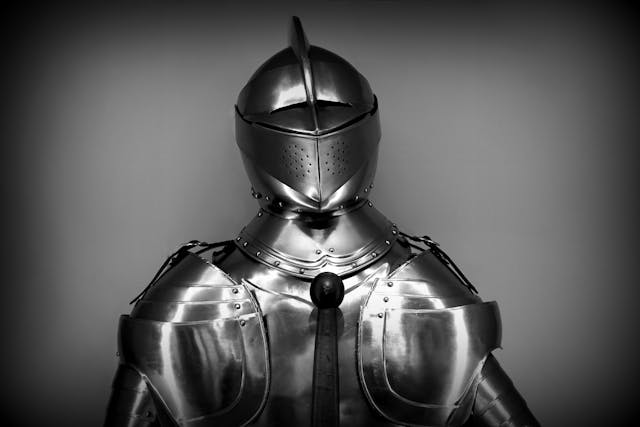
Why did knights start wearing armor? Technological advances in metallurgy and changes in society made it possible.
Soldiers have always used some type of protection, be it a shield or a helmet. Very few people want to go into battle with only a sword and nothing to protect them. The first type of plate armor goes back to the early days of the Bronze Age and was made in Ancient Greece in roughly 1400 BC. They used shaped bronze plates to cover their chest, back, neck, shoulders, upper arms, and upper legs. The plates were fastened together using leather straps. Most of the weapons were also made of bronze and bronze armor can generally stop a bronze sword. There were lots of gaps in the armor, though, and they weren’t full protection. Rome improved on the Greek armor by breaking the plate up into segments that would move and give the soldiers more freedom of movement. They also made their armor our of iron, which is stronger than bronze.
The next major improvement was chainmail. When I say “next”, it was already being used from about the 5th century BC by the Celts, living in Britain. Chainmail was made with thousands of interlocking rings. They were close enough together that they could stop a sword, or possibly even an arrow, but they were small enough that they made the armor lighter than plate and they moved very freely. Worn over or under a leather vest protected the wearer against many different types of attacks. Soldiers wore a thick jacket under the chainmail because it stopped a sword cutting the skin, but the force of the blow could easily break bones. The Romans liked what they saw and took up chainmail.
After the Roman Empire fell, chainmail was still popular, but the main problem was that it is too expensive. After the Roman Empire withdrew, Europe was an agricultural economy, and the only way to produce enough food for everybody was to have as many able-bodied people working as possible. To make a suit of chainmail, you need people to mine the iron and you need blacksmiths to melt and work the iron. These are people that are not growing food, which is not something most people can afford. Only the wealthy could afford chainmail and it was very often passed down through the generations of a family.
So, how do we go from people barely being able to afford chainmail in the 5th century to knights having suits of plate armor in the 15th century? There were several major changes that made this possible. After the end of the Roman Empire Europe was in financial turmoil. There was barely enough food to go around and there were frequent famines. Very few people could afford to make armor. This changed in the 11th century when the horse collar was introduced from China and the plow and horseshoes were invented. Before this, most agricultural work was done with oxen because any horse collar went around the horse’s neck, restricting its breathing. About 1,000 years before, a horse collar that went around the horse’s shoulders had been invented in China and this didn’t stop the horse from breathing. Horses can pull far more and much faster than an ox and the new collar allowed them to. This was exported to Europe in the 11th century and people could use horses rather than oxen, increasing the speed they could work. The horseshoe was also invented, which meant horses could work for longer and grip more. And the plow was invented, allowing people to break up land that was previously considered too hard. The amount of available agricultural land increased and it is estimated that the amount of food produced between 1000 and 1300 tripled. With this, wealth increased and there was a new middle class. Education increased and there were more technological breakthroughs.
The inventions that made plate armor possible were the invention of the waterwheel powered bellows and waterwheel powered hammer. Before this, blacksmiths used hand powered bellows to supply air to their furnaces. Humans can not apply enough force fast enough to heat up the furnace enough to properly melt iron. It is also difficult to properly hammer the metal with a human powered hammer. That changed when the someone realized that a waterwheel could be used to pump air. With more air, furnaces became hotter, and it was possible to properly melt iron. The waterwheel also powered a hammer, making it possible to accurately mold the shapes.
The fact that fewer farmers were needed and there was more money in the economy made it possible to have people fulfil more skilled and specific jobs, like blacksmithing. And more money in the economy meant that more people could afford armor, creating the demand. And full body armor took off. There was then a whole secondary revolution of making weapons that could penetrate the armor, but that is for another day. And that is what I learned today.
Photo by Mike Bird: https://www.pexels.com/photo/gray-scale-photography-of-knight-350784/
Sources
https://www.worldhistory.org/article/1692/roman-armor–weapons
https://www.itakehistory.com/post/horse-power
https://shop.minimuseum.com/blogs/specimens/a-millennia-of-chainmail
https://en.wikipedia.org/wiki/Plate_armour
